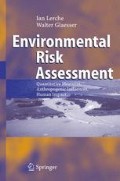Summary
Investigations at the Cospuden/Zwenkau dump show that as sources for CO2 in the lignite open pit mining dumps, both lignite particles as well as carbonate dissolution come into question. The lower dump material was laid down as the waste material after lignite mining, and was set down in the form of ribs parallel to the exhumation direction; it makes up about 2/3 of the dump mass. The surface of this first component was let sit fallow for many years and so had an intensive air admittance before the overlying cover material, made up of local materials, was superposed. The residual large quarries, due to coal excavation, were flooded and converted to lakes. The change in the lake levels with time, and the horizontal influx of lake waters into the dump, means that carbon dioxide is altered from free phase gas to gas in water solution with concomitant changes in dissolution and out-gassing capabilities.
The mining spoils that were redumped had the consequence that the original formations were destroyed, as were the various water transport pathways through the geologically deposited rocks, and the redeposition was a mix of unconsolidated spoil material. Because of aeration (ground water withdrawal), naturally occurring reducing anaerobic regions were changed to aerobic oxidizing conditions. Near the formations impeding gas exchange at the dump surface a considerable amount of carbon dioxide would seem to be dissolved in water. Measurements of the carbon dioxide flow at the dump surface show no increase in out-gassing rate relative to a control area outside the dump region.
Isotopic composition of the carbon dioxide from many probes through the dump speaks out against the origin from various sources. The negative δ13C values (between −24.5 to −26.5 ‰) imply a dominant organic origin rather than one from carbonate dissolution.
Out-gassing measurements show that, despite the higher carbon dioxide content of the lignite open pit dump in comparison to ordinary earth, no enhanced emission rate is seen. For the organic and carbonate contents in the dump materials, one can calculate the maximum possible carbon dioxide development. From one tonne of lignite (water content 52%, coal material content 48%) there results about 582 m3 CO2 from burning (corresponding to about 1144 kg). Paying attention to the fact that the dump is composed of about 2/3 underlying dump materials and about 1/3 of overlying dump material, there is about 29 kg of coal material per tonne of mixed dump material. From this figure one can obtain about 106 kg (54 m3) of carbon dioxide. Because the extraction of each tonne of lignite required three tonnes of mining “spoils”, the carbon dioxide amount that could be produced by direct burning of lignite in the atmosphere can be further increased by about 30% as a consequence of oxidation and carbonate dissolution processes in the dump itself.
Access this chapter
Tax calculation will be finalised at checkout
Purchases are for personal use only
Preview
Unable to display preview. Download preview PDF.
Rights and permissions
Copyright information
© 2006 Springer-Verlag Berlin Heidelberg
About this chapter
Cite this chapter
(2006). Carbon Dioxide Development and the Influence of Rising Groundwater in the Cospuden/Zwenkau Dump: Observations and Inferences. In: Environmental Risk Assessment. Springer, Berlin, Heidelberg. https://doi.org/10.1007/3-540-29709-X_3
Download citation
DOI: https://doi.org/10.1007/3-540-29709-X_3
Publisher Name: Springer, Berlin, Heidelberg
Print ISBN: 978-3-540-26249-7
Online ISBN: 978-3-540-29709-3
eBook Packages: Earth and Environmental ScienceEarth and Environmental Science (R0)

